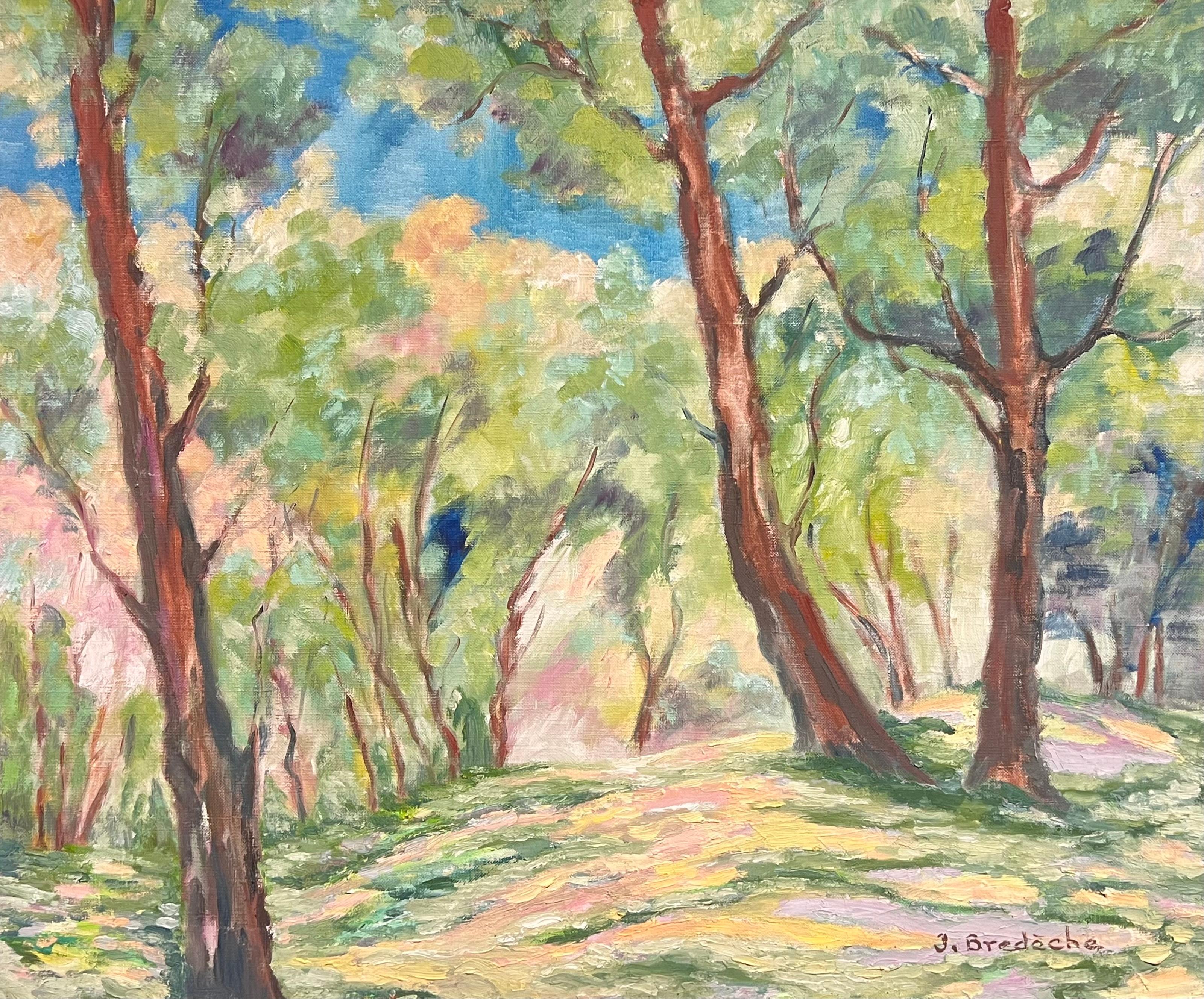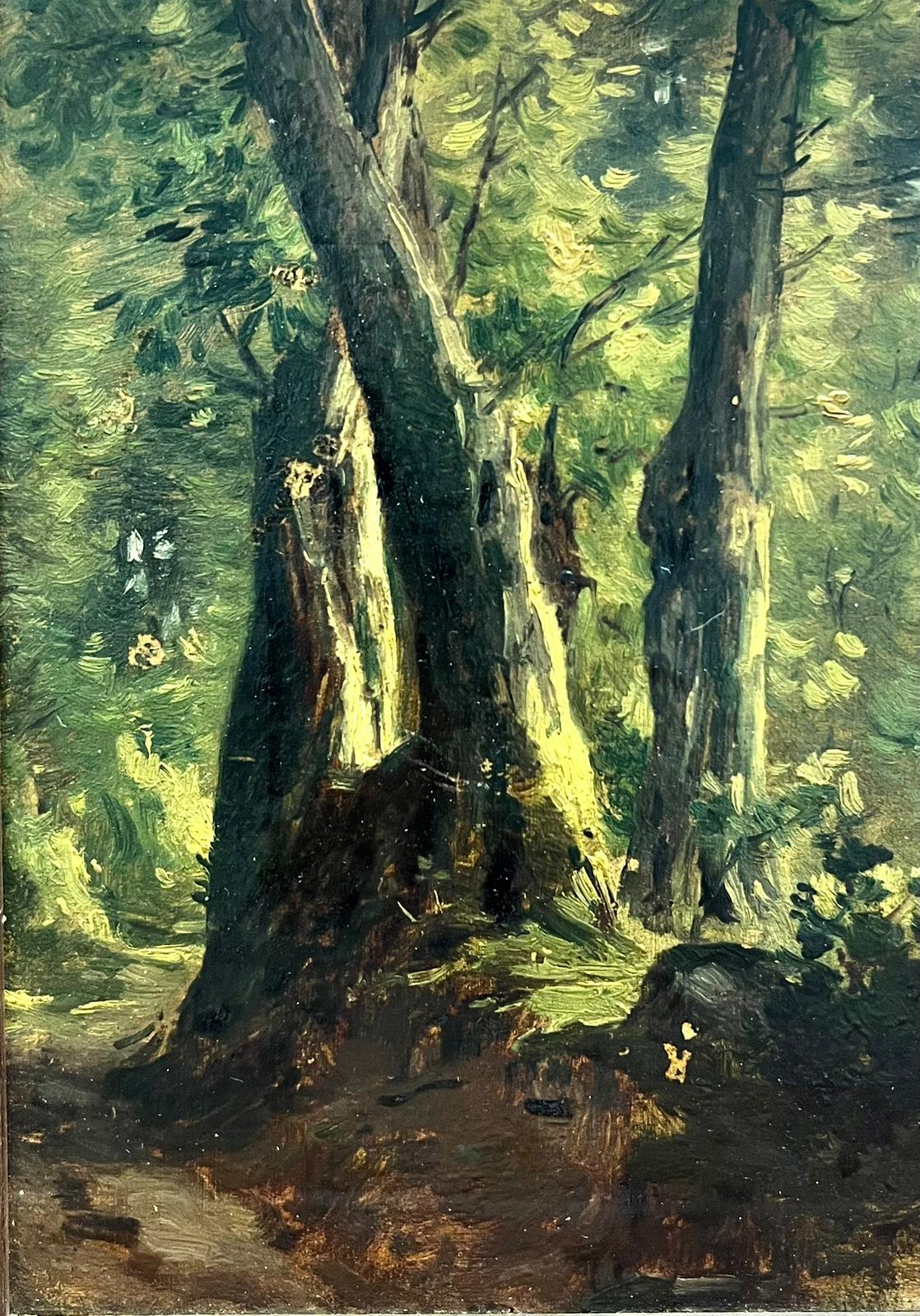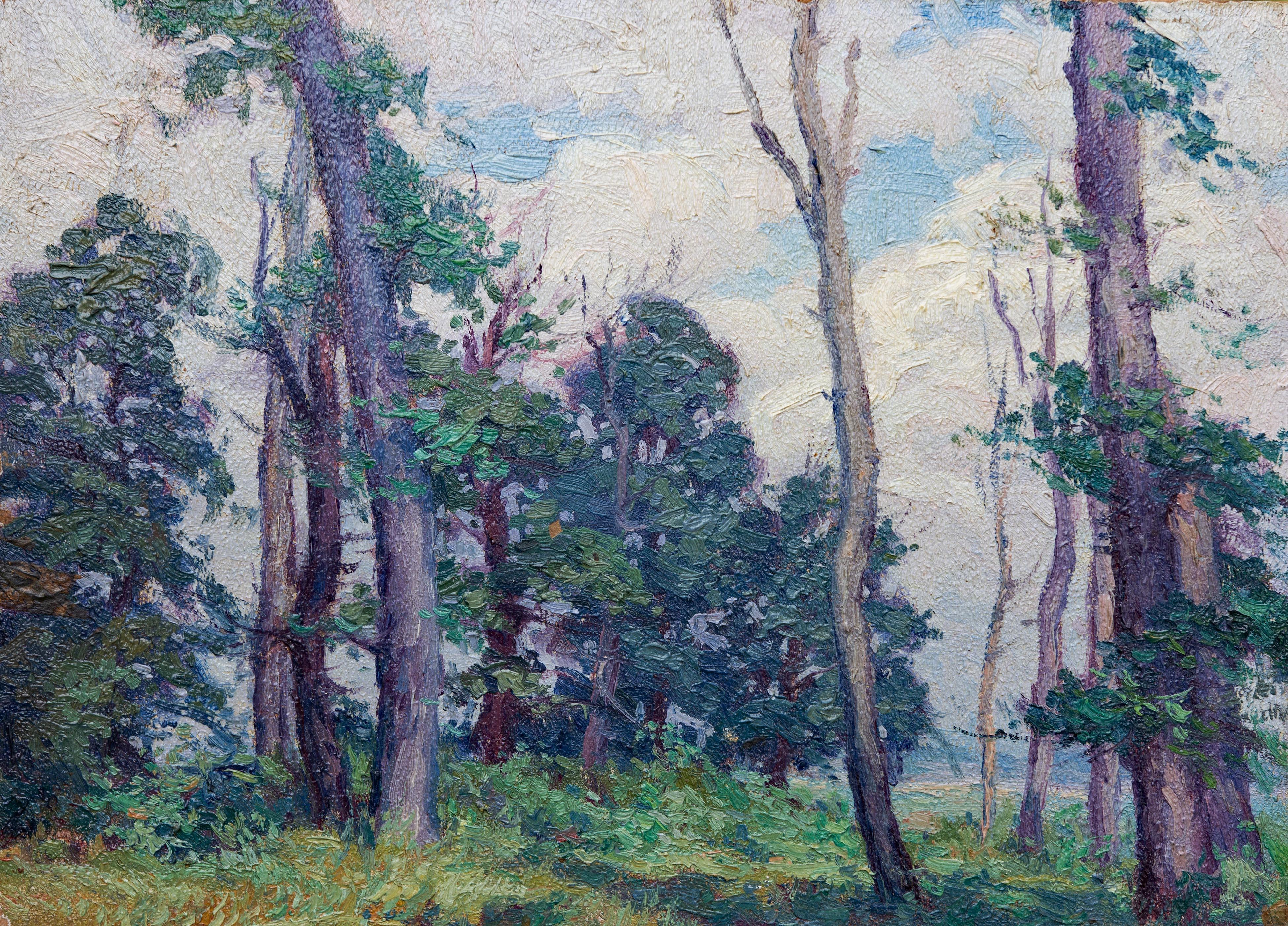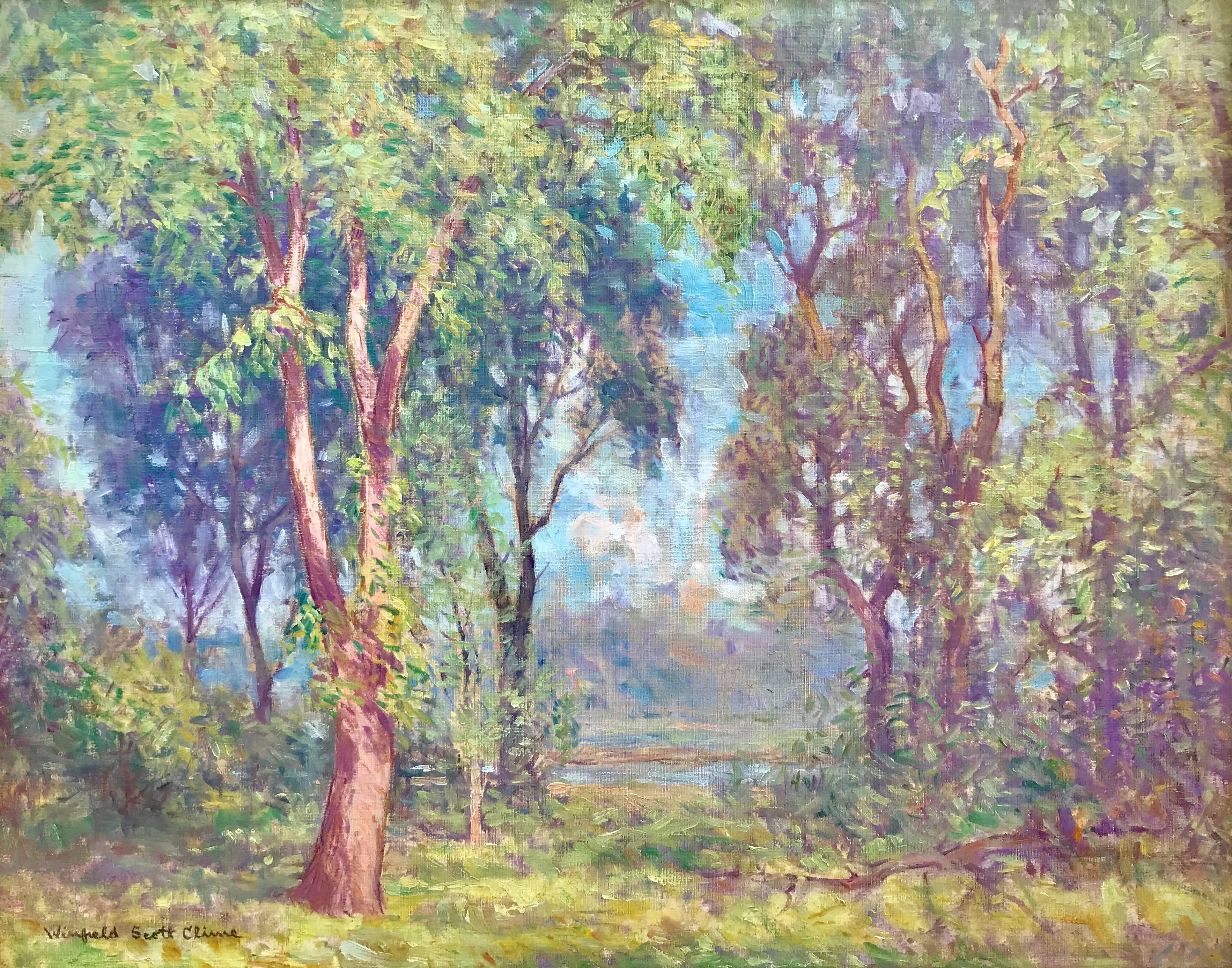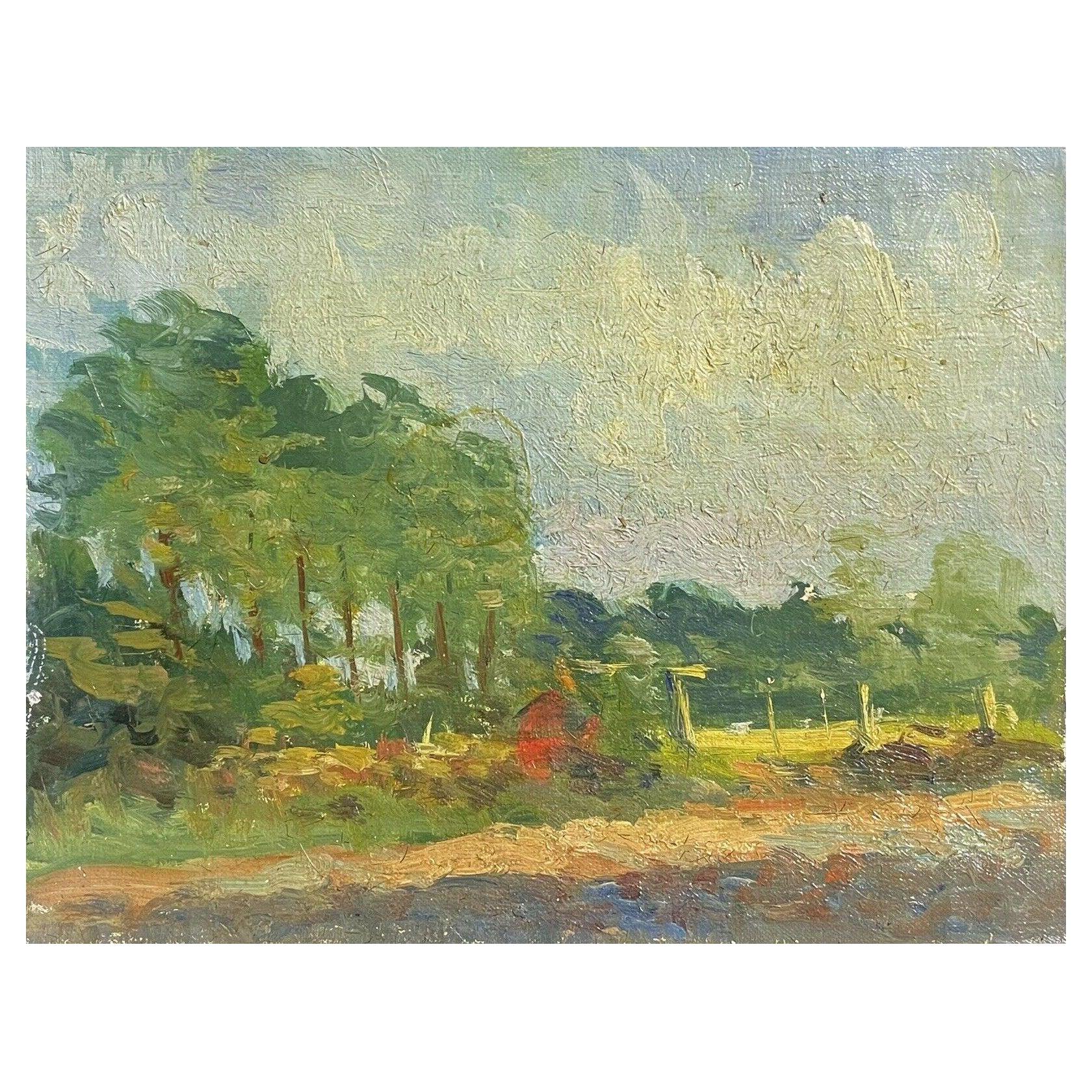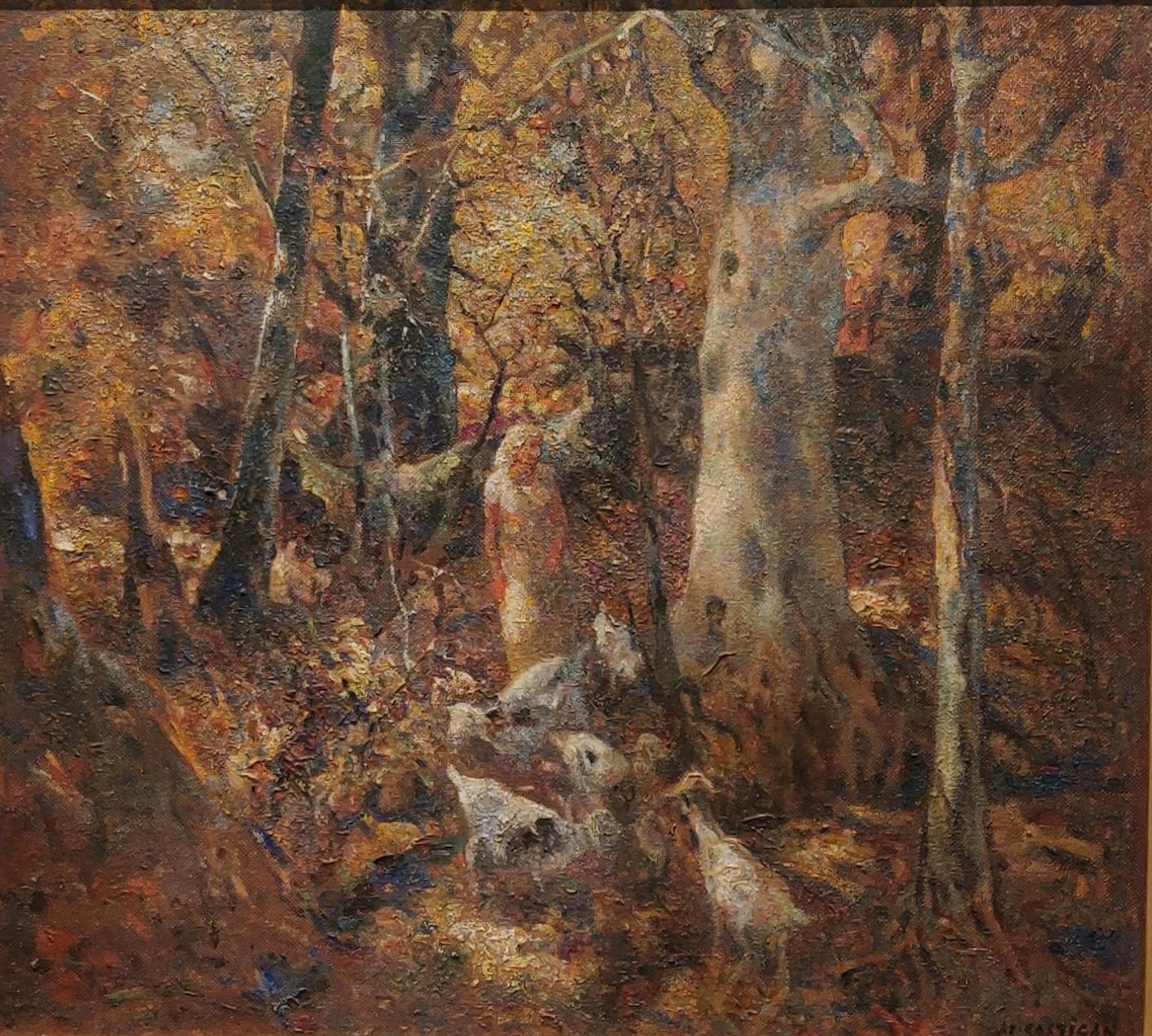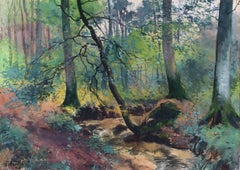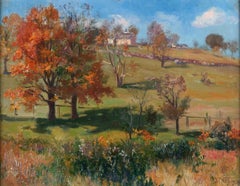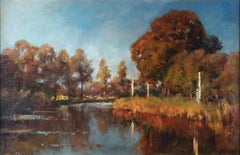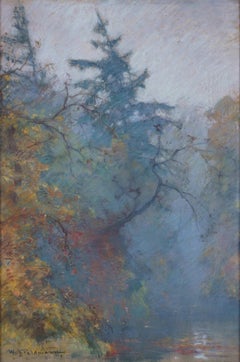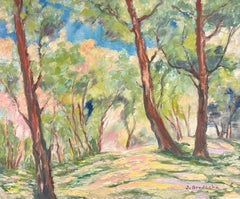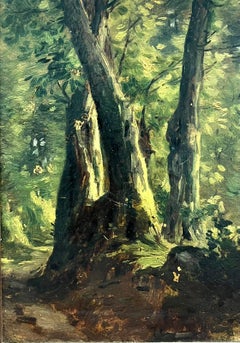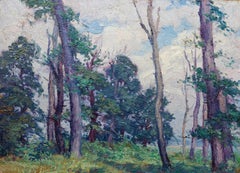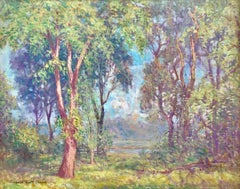Items Similar to Forest landscape bathed in sunlight / - The Monumentality of the Forest -
Want more images or videos?
Request additional images or videos from the seller
1 of 9
Wilhelm FeldmannForest landscape bathed in sunlight / - The Monumentality of the Forest -c. 1900
c. 1900
$1,162.85
£863.12
€980
CA$1,613.43
A$1,807.69
CHF 940.08
MX$21,901.54
NOK 11,977.02
SEK 11,180.96
DKK 7,461.80
About the Item
Wilhelm Feldmann (1859 Lüneburg - 1932 Lübeck), Sunny forest landscape, c. 1900. Oil on canvas, marouflaged on wood, 37 cm x 48 cm (inside dimensions), 42.5 cm x 53.5 cm (frame), signed “Wilh.[elm] Feldmann.” lower left. Framed.
- Sporadically stained in the right area, small losses of color above the signature, otherwise in good condition for its age
- The Monumentality of the Forest -
In contrast to French Impressionism, which used a very similar brushwork technique, Wilhelm Feldmann models a forest landscape with impasto brushstrokes dominated by dark tones. The treetops form a green-black wall in the background, but the light blue sky breaks through. Light is also falling into the forest from above, while the meadow where we are walking is interspersed with bright patches of light. Because of the dark colors, the sunlight is able to shine particularly brightly. The resulting contrast between light and dark makes the gloomy tree we are approaching look like a heroic natural monument, merging with the other trees to form a carpet of color that dominates the picture.
With this painting, Wilhelm Feldmann proved to be a master student of Eugen Bracht, with whom he had studied in Berlin.
About the artist
After beginning his art studies at the Munich Academy in 1878, he transferred to the Karlsruhe Art Academy in 1883, where he studied under Gustav Schönleber. From 1886 to 1900 he studied at the Berlin Art Academy, where he attended the master class of Eugen Bracht. Hans Meyer taught him etching and lithography. After completing his studies, Feldmann worked as a freelance artist in Berlin. In 1905 he moved to Mölln, where he ran an art school for women, who were banned from attending academies until 1918. In 1913 he finally moved to Lübeck. Feldmann devoted himself primarily to landscape painting. His lyrical, atmospheric paintings were highly regarded, and he was one of the most sought-after landscape painters of his time.
GERMAN VERSION
Wilhelm Feldmann (1859 Lüneburg - 1932 Lübeck), Sonnendurchlichtete Waldlandschaft, um 1900. Öl auf Leinwand, auf Holz maroufliert, 37 cm x 48 cm (Innenmaß), 42,5 cm x 53,5 cm (Rahmen), links unten mit „Wilh.[elm] Feldmann.“ signiert. Gerahmt.
- im rechten Bereich vereinzelt fleckig, kleine Farbverluste über der Signatur, sonst in einem altersgemäß guten Erhaltungszustand
- Die Monumentalität des Waldes -
Mit pastos aufgetragenen Pinselstrichen modelliert Wilhelm Feldmann eine Waldlandschaft, die – im Gegensatz zum französischen Impressionismus, der sich einer ganz ähnlichen Pinseltechnik bedient – durchaus von dunklen Tönen dominiert wird. Die Baumkronen bilden im Hintergrund eine grünschwarze Wand, durch die allerdings der hellblaue Himmel hindurchbricht. Darüber fällt auch von oben Licht in den Wald hinein, während die Wiesenfläche, auf dessen Weg wir uns befinden, von hellen Lichtflecken durchsetzt ist. Aufgrund der dunklen Farbigkeit vermag das Sonnenlicht besonders aufzustrahlen. Durch den damit gegebenen Hell-Dunkel-Kontrast tritt der düstere Baum, auf den wir zulaufen, wie ein heroisches Naturmonument in Erscheinung, das sich mit den anderen Bäumen zu einem bildbeherrschenden Farbteppich zusammenschließt.
Mit diesem Gemälde erweist sich Wilhelm Feldmann als Meisterschüler Eugen Brachts, bei dem er in Berlin studiert hatte.
zum Künstler
Nach der Aufnahme des Kunststudiums an der Münchener Akademie im Jahre 1878, wechselte er 1883 an die Kunstakademie Karlsruhe und studierte dort bei Gustav Schönleber. Von 1886 bis 1900 war er dann an der Berliner Kunstakademie und besuchte dort die Meisterklasse von Eugen Bracht. Hans Meyer unterrichtete ihn in der Kunst der Radierung und der Lithographie. Nach dem Studium war Feldmann zunächst in Berlin als freischaffender Künstler tätig. 1905 erfolgte ein Umzug nach Mölln, wo er eine vorwiegend von Frauen besuchte Malerschule unterhielt, denen bis 1918 der Zugang zu den Akademien untersagt war. 1913 zog er schließlich nach Lübeck. Künstlerisch widmete sich Feldmann vor allem der Landschaft. Seine lyrischen Stimmungsbilder erfreuten sich einer großen Wertschätzung und er war einer der gefragtesten Heidemaler seiner Zeit.
- Creator:Wilhelm Feldmann (1859 - 1932, German)
- Creation Year:c. 1900
- Dimensions:Height: 14.57 in (37 cm)Width: 18.9 in (48 cm)Depth: 1.58 in (4 cm)
- Medium:
- Movement & Style:
- Period:
- Condition:
- Gallery Location:Berlin, DE
- Reference Number:1stDibs: LU2438215665792

About the Seller
5.0
Vetted Professional Seller
Every seller passes strict standards for authenticity and reliability
Established in 2014
1stDibs seller since 2023
21 sales on 1stDibs
- ShippingRetrieving quote...Shipping from: Berlin, Germany
- Return Policy
Authenticity Guarantee
In the unlikely event there’s an issue with an item’s authenticity, contact us within 1 year for a full refund. DetailsMoney-Back Guarantee
If your item is not as described, is damaged in transit, or does not arrive, contact us within 7 days for a full refund. Details24-Hour Cancellation
You have a 24-hour grace period in which to reconsider your purchase, with no questions asked.Vetted Professional Sellers
Our world-class sellers must adhere to strict standards for service and quality, maintaining the integrity of our listings.Price-Match Guarantee
If you find that a seller listed the same item for a lower price elsewhere, we’ll match it.Trusted Global Delivery
Our best-in-class carrier network provides specialized shipping options worldwide, including custom delivery.More From This Seller
View AllSummer Forest Landscape, 1915 / - The Forest Walk -
Located in Berlin, DE
Stanislas Warnie (1879-1958), Summer Forest Landscape, 1915. Watercolor, 31.5 cm x 45 cm (passepartout), 50.5 cm x 63.5 cm (frame), signed "S. Warnie" at lower left and dated "1915"....
Category
1910s Art Nouveau Landscape Drawings and Watercolors
Materials
Watercolor
$617 Sale Price
20% Off
Autumn Landscape in Sunlight - Indian Summer -
Located in Berlin, DE
Frederick Vezin (1859 Torresdale Philadelphia - 1933 Düsseldorf), Autumn Landscape in the Sunlight, oil on canvas, mounted on cardboard, 32 x 41 cm (inside measurement), 44 x 51 cm (frame), signed and dates lower right "F. Vezin. [19]05".
- Cardboard slightly curved, small inconspicuous retouch at the centre of the upper edge of the picture.
About the artwork
Although the painting appears to be a sketch, Frederick Vezin considered it to be a finished work of art, as evidenced by his signature on the lower right. And it is precisely this sketchy quality that leads to an understanding of the painting, which was certainly created in the landscape itself: the natural phenomena were to be depicted artistically at the moment of their observation. This is not done by meticulously sketching nature, but - and here Vezin follows the teaching of French Impressionism - by illustrating nature in its visual fullness. The artist's eye is, as it were, immersed in the visuality of nature, which is made visible by his hand. The painting is therefore not a reflection of the landscape, but its artistic intensification.
This intensification also includes the fact that the foreground of the painting - corresponding to the field of vision - eludes a detail-oriented close-up view. Instead, the spatula-like application of paint, the vertical structure of which corresponds to the structure of the floral growth, has the effect of making nature tangible in its colourful substance.
At the same time, the foreground, which remains indeterminate in its concrete objectivity, creates an atmospheric space that connects with the actual protagonist of the picture, the group of trees, which flares up in shades of red and brown. Here, too, the leaves are more speckled than clearly outlined. It is precisely this 'sketchiness' that opens up a visual experience that makes the landscape accessible in its visual fullness, thus revealing its essence.
In addition to this abundance, the landscape is presented as a structure of order in that the composition of the picture makes the composition of the landscape visible. For example, the group of trees forms a distinct dark green shadow, which is repeated in the shadows cast by the trees behind it. A patterned diagonal axis is created in the picture, which is composed in this way by the landscape itself.
Strictly speaking, this is a cultivated landscape: a fence at the bottom and a low stone wall at the top, running from left to right, are two elements that also have a strong compositional effect. And on the top of the hill, a stone house is embedded in the landscape as the brightest surface in the picture. Nature and culture here form a harmonious synthesis, giving the painting an Arcadian touch.
In order to give the landscape as much space as possible, the horizon line is raised, but the design of the sky is also crucial. The clouds, combined with the shapes of the trees, create a bright blue sky. To the European eye, such a sky is reminiscent of a summer landscape. Accordingly, within the seasonal cycle, the blue sky is reserved for summer, and French Impressionism is also primarily an ode to summer. In Vezin's painting, however, the brilliant blue sky stands above an autumnal landscape, some of the trees even defoliated. It can therefore be assumed that the painting was made not in Europe but in the United States, and that it illustrates the proverbial Indian summer, making Frederick Vezin a pioneer of American landscape painting.
About the artist
Frederick Vezin was the son of a French immigrant to the United States and a German-born mother. This predestined him to promote artistic exchange between the old and new worlds. Having spent part of his schooling in Germany, in 1876, at the age of 20, he enrolled at the Düsseldorf Academy of Art, where he studied with Peter Janssen the Elder, Eduard von Gebhardt and Wilhelm Sohn, among others. He graduated in 1883, settled in Munich and returned to Düsseldorf in 1895, where he lived until his death in 1933.
A native of the United States, he travelled to the country frequently and became a popular portrait and society painter. His artistic talent, however, was most evident in his landscape paintings. Trained in French Impressionism, he developed a virtuoso use of colour and a free brushwork that remained tied to the landscape motif, opening up the landscape itself in a new way. Frederick Vezin turned his attention primarily to the landscape of his homeland, becoming a pioneer of modern American landscape...
Category
Early 1900s Impressionist Landscape Paintings
Materials
Cardboard, Oil
$2,088 Sale Price
20% Off
Late Summer River Landscape / - Realistic Impression -
By Jan Hillebrand Wijsmüller
Located in Berlin, DE
Jan Hillebrand Wijsmuller (1855 Amsterdam - 1925 ibid.), Late Summer River Landscape, oil on canvas, relined, 34 x 56 cm (inside measurement), 43 x 64 cm (frame), signed J[an] H[illebrand] Wijsmuller at lower right.
- in good condition, the frame with isolated bumped spots
- Realistic Impression -
About the artwork
The panoramic landscape format shows a river landscape, with the course of the river, which curves to the right, leading the eye into the depths of the picture and tempting it to continue the landscape in the imagination beyond the visible area. At the same time, however, the fact that the landscape is not visible through the bend in the river focuses our gaze on the entirety of the landscape depicted, without prompting us to focus on distant details. Accordingly, the brushstroke is not designed to render details with realistic precision. In the front left area of the river there is even a completely free brushwork, trained by Impressionism, which nevertheless remains committed to representational and convincingly suggests the movement of the water.
Regardless of the distance of the observer, the entire picture is painted with the same broad brushstroke, so that the landscape is given as an impression. And yet this impression is not ephemeral, as in the case of French Impressionism, to put it exaggeratedly, but reveals to us the essence of the landscape in all its richness. This is why the Dutch variant of Impressionism is always also a realism, although the pictures appear less progressive, but still contain a dimension of landscape painting that is lost with progress.
In the impression, the reality of the landscape is revealed, and this happens as we experience the landscape in the visual impression. Wijsmuller does not depict houses or people in order to allow the experience of the landscape to fully unfold. The experience is determined first and foremost by the river, which does not flow into the picture from our point of view, but towards us. Where the river begins to bend, the water is churned by a rapids. Toward us, the riverbed widens and the water comes to rest, covering the entire width of the foreground like a mirror.
The stillness of the water corresponds to the evening mood of the late summer landscape, in which the warm tones of the evening light blend with the yellow and brown tones of the plants. A gentle, almost idyllic reality, carried by the brushstroke, yet animated by a liveliness that is also made visible by the brushstroke. The broad, dynamically placed brushstrokes evoke the movement of the treetops and animate even the immobile reeds, while the trunks on the right bank, executed in virtuoso white strokes that seem like markings, make the sunlight shine. On the other bank, a carpet of light also spreads out, its energetic effect again expressed in the brushstroke. The dynamic of the landscape is further enhanced by the complementary color contrasts between the greens, yellows, and browns on the one hand and the blue of the all-encompassing sky on the other. A contrast that is intensified by the reflection in the water.
The evening coming to rest of the landscape is thus at the same time an all-encompassing contrasting and yet in itself harmonious movement. This reality becomes accessible to us as an experience in the impression of the landscape.
About the artist
Jan Hillebrand Wijsmuller entered the Royal Academy of Arts in Amsterdam in 1876 and studied under the innovative Professor August Allebé, who was famous for the Amsterdam Impressionism, also known as the Allebé School.
In 1877, Wijsmuller transferred to the Hague Academy of Art, and thus to the Hague School, and then completed his studies at the Brussels Academy of Art. Returning to the Netherlands, Wijsmuller opened his own studio in Amsterdam.
In 1883 he won the prestigious Young Artist Award, donated by Willink van Collen, which made Wijsmuller a well-known and sought-after artist.
Wijsmuller was a member of the Societät Arti et Amicitiae Amsterdam and the Pulchri Studio in The Hague.
Wijsmuller belongs to the second generation of the Hague School. While Vincent van Gogh described the protagonists of the first generation to his brother Theo as "the great gray people," the second generation, and Wijsmuller in particular, used a much more colorful palette. His oeuvre makes him a major player in Dutch Impressionism...
Category
1890s Impressionist Landscape Paintings
Materials
Canvas
$3,607 Sale Price
20% Off
Impressionist Autumn Landscape with Lake / - Diffuse Concretion -
Located in Berlin, DE
Wilhelm Feldmann (1859 Lüneburg - 1932 Lübeck), Impressionist autumn landscape with lake, around 1905. Pastel on cardboard, 46 cm x 31 cm (inside dimension), 52 cm x 37 cm (frame), s...
Category
Early 1900s Impressionist Landscape Paintings
Materials
Gouache
Shady hollow way - Into the heart of the forest -
By Hans Dvoràk
Located in Berlin, DE
Hans Dvořák (19th century). Shady hollow way in a sunny forest. Watercolour and pen-and-ink drawing, 58.5 x 43 cm (visible size), 70 x 55.5 cm (frame), signed and dated "Hans Dvořák ...
Category
1880s Realist Landscape Drawings and Watercolors
Materials
Watercolor
$1,328 Sale Price
20% Off
In the forest of Durlach - Quiet ripple in a secret place -
Located in Berlin, DE
Franz Xaver Graessel (1861 Oberasbach/Baden - 1948 Emmering). In the forest of Durlach. 1881. Pencil drawing, heightened with white, on grey-green paper. 33 x 41.7 cm. Signed, dated and inscribed by the artist himself: 'Franz Graessel. Durlach, 12 April 1881".
About the artwork
The drawing depicts a view of the woods which, as if sharpening the visual focus, remains diffuse at the edges and does not allow the viewer to locate himself in the picture. As a result, the landscape appears to be an apparition, but at the same time it is given real substance by the solidity of the massive arched bridge made of quarry stone. As the main motif of the painting, the bridge, which blends in with nature like an archaic relic, also acts as a visual guide, drawing attention to the white, raised waters of the stream and the surrounding vegetation. The diffusion of perception that takes place there, however, draws the eye back to the bridge and thus to the overall view. This movement initiating a constant alternation of diffusion and concretion, which is the specific tension of the painting that brings the landscape to life. The materialisation and dematerialisation, however, does not take place solely through the eye's wandering through the picture; it is simultaneously linked to the viewer's approach to and distance from the picture, which loses its richness of detail precisely in the close-up, only to reconfigure itself with increasing distance.
In this work, which dates from Graessel's studies in Karlsruhe, the artist reflects on the emergence of pictorial objectivity. Here, however, nature is more than a mere motif. The real connection between culture and nature is symbolically expressed by the choice of green paper.
The drawing is an impressive testimony to Graessel's mastery of the sprezzatura with which he skilfully applies the most abstract of strokes, which visibly merge towards the centre of the picture. The signature and the exact date prove that Graessel gave this work more than the character of a mere sketch.
About the artist
Franz Graessel grew up in an environment that was to nourish his later key motifs: his parents' house was a mill. After attending the Karlsruhe Academy of Art from 1878 to 1884, where he studied under Carl Hoff, Graessel continued his training at the Munich Academy from 1886 to 1890 as a pupil of Wilhelm von Lindenschmidt. Trained primarily in genre and portrait painting, he initially portrayed the life of Black Forest farmers. From 1894 he turned increasingly to animal painting, concentrating on the depiction of ducks and geese, which earned him the nickname 'Enten-Graessel'. Graessel's work thus parallels that of Alexander Koester...
Category
1880s Naturalistic Landscape Drawings and Watercolors
Materials
Chalk, Pencil, Paper
$2,278 Sale Price
20% Off
You May Also Like
Sunlit Woodland Landscape Large 1970's French Impressionist Oil Painting
Located in Cirencester, Gloucestershire
Sunlit Forest
French School, 1970's
signed by J.Bredeche ( French School)
oil on canvas, unframed
Canvas : 21 x 25.5 inches
Inscribed verso
Provenance: private collection, Paris
Cond...
Category
Mid-20th Century Post-Impressionist Landscape Paintings
Materials
Canvas, Oil
Dappled Sunlight Woodland Path in Landscape Antique French Landscape Oil
Located in Cirencester, Gloucestershire
by Sylvain Grateyrolle (French b. 1849)
oil on board, framed
inscribed verso
size: 8.5 x 6.5 inches
board: 7.5 x 5.5 inches
private collection, France
The painting is in overall ver...
Category
19th Century Impressionist Landscape Paintings
Materials
Oil
Impressionist Landscape by American Artist George Renouard
By George Renouard
Located in Rochester, NY
Impressionist landscape by George Renouard. Beautiful blues and mauves. Oil on academy board. Unsigned.
George Renouard, was born in Rochester, New York and lived much of his life ...
Category
Early 20th Century Landscape Paintings
Materials
Oil, Board
“Woodland Vista”
By Winfield Scott Clime
Located in Southampton, NY
Oil on artist board painting by the American artist, Winfield Scott Clime. Signed lower left. Titled verso. Partial Lyme Association exhibition label verso. In good condition. Frame...
Category
1930s Post-Impressionist Landscape Paintings
Materials
Oil, Board
$5,400 Sale Price
43% Off
Maurice Mazeilie French Impressionist Oil- Golden Light Woodland Field
Located in Cirencester, Gloucestershire
"Golden Light"
by Maurice Mazeilie (French)
oil painting on canvas, unframed
painting: 8 x 10 inches
A delightful original oil painting by the 20th century French Impressionist art...
Category
20th Century Landscape Paintings
Materials
Acrylic
"Through the Woods" John E. Costigan, Early 20th Century Landscape Painting
Located in New York, NY
John Edward Costigan
Through the Woods
Signed lower right
Oil on masonite
30 x 27 1/2 inches
John Costigan was a self-taught painter and trained printer distinguished by his impres...
Category
Mid-20th Century Landscape Paintings
Materials
Canvas, Oil
More Ways To Browse
Antique Bath
Antique Kunst
Bath Wall Art
Gloomy Art
Antique Black Wood Stain
Forest Etching
Antique Green Picture Frames
Elm Tree
Antique Wand
Warren Long
Aspen Mountain Art
Cliff House
Horse And Carriage Painting
Large Pastoral Oil Paintings
Oil Painting Mountains Scottish
River Landscape With Cottage
Texas Mission
36 X 42 Painting
